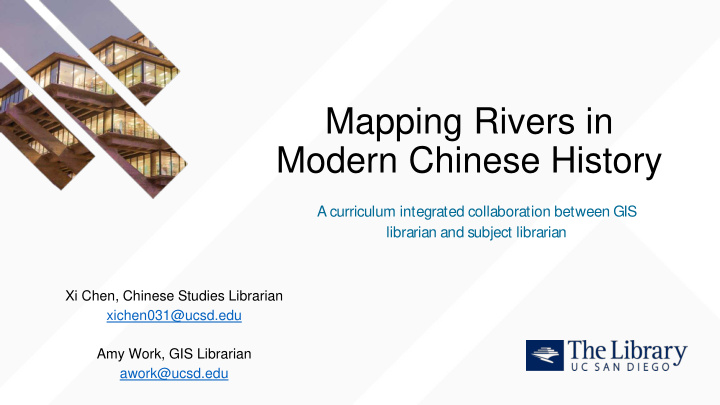



Mapping Rivers in Modern Chinese History A curriculum integrated collaboration between GIS librarian and subject librarian Xi Chen, Chinese Studies Librarian xichen031@ucsd.edu Amy Work, GIS Librarian awork@ucsd.edu
Course: Mapping Rivers in Recent Chinese History: 1824 - 2017 Learning Objectives Understand the relationships between rivers and China’s recent ecological, economic, 1. social, and military history Use evidence to make arguments about the relationship between societies and their 2. environment. Evaluate data from textual and quantitative sources: what can we do with it, and 3. where should we be cautious? Plan and execute a piece of original research to answer a question that interests you. 4. You will use publicly available data and ArcGIS Geographic Information Systems software to do a final project about China’s rivers and society. Present your findings both orally and in writing, and critically evaluate a colleague’s 5. work.
Our objectives Three approaches to support professor and course objectives 1. Professor support (meetings) 2. Embedded student instruction 3. Student consultations for group projects
Embedded instruction: Co-teaching • Session 1 : Intro to Chineses Stats resources and China Geo-Explorer Online • Statistical Resources - China Data Online, China EPS, CEIC • Download statistical data and Shapefiles from China Geo Explorer. Use ArcMap
Embedded instruction: Co-teaching • Session 2 : G eoreferencing of historical maps David Rumsey Map Collection • ArcMap • New map of Shanghai. Published by K. Saito. Osaka Japan, 1909. David Rumsey Map Collection https://www.davidrumsey.com
Embedded instruction: Co-teaching • Session 3: Project Support • Open time for students to work on projects
Group projects • Students worked in groups of 2-6. They organized themselves in groups. Formation and composition of the groups • • Example project topics How did the construction of the Three Gorges Dam benefit crops yields in Hubei • Province? The influence of the change of Ice-breaking time ( 凌汛时间 ) to economy along • upstream yellow river, particularly in inner Mongolia.
Outside of class consultations • Nine groups • How did we logistically manage this? Both in the room at the same time? • Initially thought yes, then determined no. • Eventually structured two back to back 30 min sessions • Student questions determined who would meet first • Spontaneous meetings depending on our availabilities • * Organic process that led to this structure
Takeaways - Collaboration • Collaboration is key. Willingness to collaboration. • Leverage the domain knowledge expertise of the other • Can both talk about surface level concepts about the other’s domain • Communication essential for all (Instructor, Xi, and Amy) • Maintaining good relationships with patrons will lead to new opportunities. We will come to the minds of them when they need help, but aren’t sure where to • go / ask.
Takeaways - Resources 1 • A plethora of resources • There are free resources out there (may not give the full historical coverage) • China Geo-Explorer Online Used a trial version before this class (short trial that would not last the duration of • the class). Purchased the license for the class. • Other departments now use the database •
Takeaways - Resources 2 • Resources • Found other resources in the Library that we didn’t immediately realize we had. CD. Xi aware, but never used in consultation or class. • Revisiting of previously purchased resources • Based on the need of student questions, make sure that others are aware of • this recourse. CD now on Guide | CD now on local network data drive to improve accessibility •
Takeaways - For Next Time • What would you do differently? Extremely organic process - first time course taught, new professor • Documenting the process - just like designing the course, you have a syllabus. • Make a GIS tutorial a required homework assignment. Pts. Part of grade. Certificate • of completion from the training. (use existing trainings)
Takeaways - For Next Time • What would we do differently to enhance our own collaborations Subject Librarian desires to help a bit more with GIS questions • Increase the GIS capacity / competence of Subject Librarian • Focus on 2-3 specific commonly used functions that pertain to the discipline and • course objectives. This situation: Joining of tables and georeferencing • Joining of tables → statistics downloaded from databases to shapefiles • Georeferencing → stretching historical maps to match the “real world”. •
Takeaways • What we’ve learned Willingness to collaborate; Domain expertise • How does this relate to the “are you adequate enough to help your patrons” • Know your limitations and don’t be afraid to reach out and ask (subject / functional • librarians) This isn’t just limited to GIS, but applies to other modes of collaboration • Data science, digital scholarship, scholarly communication, research data • management, digital media, data curation.
Questions? What are your experiences? Xi Chen, Chinese Studies Librarian Amy Work, GIS Librarian xichen031@ucsd.edu awork@ucsd.edu
Recommend
More recommend